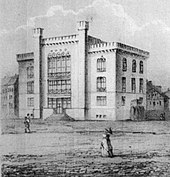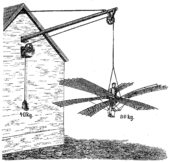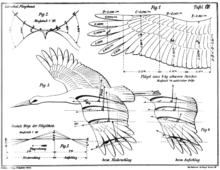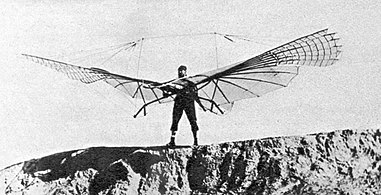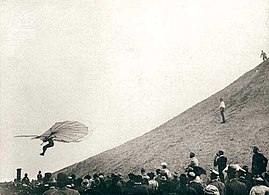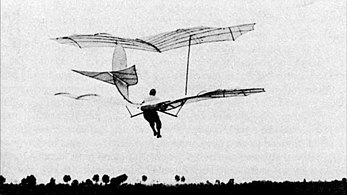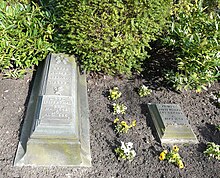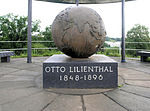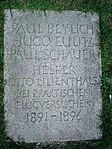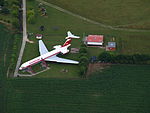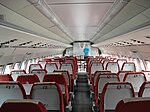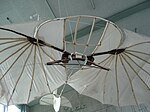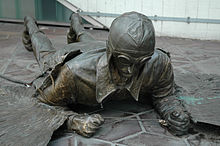Otto Lilienthal
Karl Wilhelm Otto Lilienthal (born May 23, 1848 in Anklam ; † August 10, 1896 in Berlin ) was a German aviation pioneer. He is considered to be the first person who successfully and repeatably performed gliding flights with a flying machine ( glider ) and thus helped the flight principle “ heavier than air ” to its first human application and thus paved the way for its later success. His preliminary experimental work and first flight attempts from 1891 onwards led to the concept of the wing . The representation of aerodynamic properties of wings in the polar diagramwas developed by him and is still used today. The production of the normal sailing apparatus in his machine factory in Berlin was the first series production of an aircraft. His flight principle was the conversion of positional energy into lift and propulsion (gliding flight).
life and work
childhood
Otto Lilienthal was born as the first of eight children to the businessman Gustav Lilienthal (1817–1861) and his wife Caroline, née Pohle. Lilienthal's paternal great-grandmother was Charlotte von Tigerström (1773-1857), née von Balthasar, a granddaughter of the general superintendent Jakob Heinrich von Balthasar from Greifswald . Five siblings died aged a few months or years.
The father was a mathematically and technically gifted man, the mother had studied music in Dresden and Berlin . When the family got into economic difficulties, they decided to emigrate to America. The sudden death of the father thwarted the plan to move. This happened about six weeks before Otto Lilienthal's 13th birthday.
With great effort, the mother managed to give her children a good education. Her sons Otto and Gustav Lilienthal first attended the grammar school in Anklam from 1856 onwards . The astronomer Gustav Spörer was one of her teachers . Flight tests and experiments as well as the study of bird flight already fell during this time.
The brothers remained closely connected throughout their lives through numerous projects and inventions.
training
From 1864 Otto Lilienthal attended the Potsdam provincial trade school. After two years he began an internship at the Schwartzkopff machine factory in Berlin . During this time he lived as a " sleeper boy ": he had to share his bed with a cab - and a truck driver , as he reported in a chronicle.
In 1867 and 1868 the Lilienthal brothers in Anklam built experimental devices to generate lift by flapping wings. The result was a maximum liftable mass of 40 kg. The following investigations of the curved wing in the air flow without wing flap became the decisive experiments.
The relationship between air flow and lift was not yet correctly described by physics at that time . For example, Hermann Helmholtz investigated the problem and in 1873 declared in a lecture to the Prussian Academy of Sciences that “it is hardly likely that a person could be moved by the most skilful wing-like mechanism that he would have to move with his own muscle power , would be enabled to lift and maintain one's own weight in the air ”. The statement was misunderstood, however, as if "science has now determined once and for all that humans cannot fly," as Lilienthal countered ironically in a lecture. (With lightweight materials and considerable effort, however, the first muscle-powered aircraft were also realized in the 1960s and 1970s .)
In November 1867 Lilienthal began studying at the Berlin Business Academy, which was led by Franz Reuleaux and later became the Technical University of Charlottenburg , and received a scholarship that significantly improved his living situation. His technical aviation ambitions had also not gone unnoticed at the school. After completing his training in 1870, Lilienthal turned down an offer from Reuleaux to become his assistant. In several letters from the Franco-German War , in which Lilienthal participated as a “ one-year volunteer ”, he tells his brother and mother about the balloons that left besieged Paris.
Paths to independence

The brothers' first attempts to earn money with their own business were unsuccessful. The patent application for a Stirling engine failed, the patent for a cutting machine for mining led to series production, but not to a company of its own.
On June 11, 1878 Lilienthal married Agnes Fischer (1857–1920) in Döhlen (today Freital), the daughter of a miner , with whom he had four children. In 1879 the first son, Otto, was born; daughter Anna followed in 1884, son Fritz in 1885 and daughter Helene in 1887. In 1879 Otto and his brother Gustav developed a modular system for children with stones made from mineral components bound with linseed oil. Marketing the modular system yourself did not prove to be financially worthwhile. Friedrich Adolf Richter bought the rights to the system and turned it into the Anker stone construction kit , which is still produced today.
In 1881 Lilienthal received a patent for snake-tube boilers , which brought the success they had hoped for: Together with a small wall-mounted steam engine , the Lilienthal small motor was created, which was manufactured in its own company from 1883, which quickly grew into a factory with up to 60 employees. From 1894 onwards it also produced normal sailing equipment in series, making it the first aircraft factory in the world.
Influenced by the ideas of Moritz von Egidy and Theodor Hertzka , the company was run in a very modern way. As early as 1890, the workers had a 25% share in the company's net profit. The Carl Zeiss works and the Berlin wood plaster manufacturer Heinrich Freese later became known for this measure . Lilienthal's well-known vision of the airplane as a means of international understanding and eternal peace comes from a letter to Egidy.
The steam boiler and machine factory Otto Lilienthal existed under this name until the First World War .
Another interesting entrepreneurial episode is Lilienthal's commitment to a Volksbühne in Berlin's Ostend Theater , which made him theater director, actor and author.
Theoretical preparatory work for flying
Since 1874 Otto Lilienthal led assisted by his brother Gustav with a proprietary rotating apparatus systematic measurements to lift on flat and curved surfaces by that provided unambiguous results. On the one hand, curved wings, compared to flat surfaces, provided a multiple of vertical lift with a relatively small increase in air resistance in the horizontal direction; on the other hand, the slightly curved bird wing shape had the most favorable resistance values. Mainly financial restrictions, but also the zeitgeist prevented a timely publication of his findings.
In 1889 Lilienthal published his book The Flight of Birds as the Basis of the Art of Flying , which is today considered to be the most important aviation publication of the 19th century. One of the first reviews of the book turned out to be downright prophetic:
“The peculiar work that we have before us in this work lifts a good piece of that impenetrable veil that has since hidden the true processes of bird flight so mysteriously and allows us a deep insight into the great rulership of nature in the wonders of natural flight . It is two scientifically trained technicians who have made it their life's work to devote all their knowledge and skills to the fly idea and to pursue a path of discovery undeterred and step by step, the results of which are now available to us in a rounded form. In calm and steady pursuit of their goal, the Lilienthal brothers followed their research path for more than two decades [...]. The advantage of this work is that it was not created at the desk, but in the physical laboratory and on the test field. They do not set up speculations and projects of only theoretical value, but operate on thoroughly practical ground. But that makes this work indispensable for everyone who wants to deal in any way with questions of flight technology; because it is not conceivable that a real calculation from the field of dynamic flight could be justified without using the material offered in this work [...]. "
Nevertheless, the book received little attention at the time, as the general public favored aviation based on the principle of lighter-than-air , the evolution of the balloon into an airship . Lilienthal, on the other hand, called this a wrong path and emphasized: “It must also be possible for humans to imitate gliding, since it only requires skillful steering, for which human strength is completely sufficient.” Lilienthal developed his theory exclusively from his own experiments. Presumably he was also unfamiliar with the similarly intended book Das Reich der Lüfte ( L'empire de l'air ) by Louis Mouillard , published in France in 1881 .
The brothers had recognized that the wing cross-section was of great importance: "The most important finding of these years was the discovery that curved wings provide greater lift than flat ones." for the first time combined with exact measurements. The Wright brothers later said of Lilienthal's tables that they had been the best in print for over two decades. Lilienthal's approach (“From step to jump, from jump to flight”) finally enabled the successful gliding flight . In the Association for the Promotion of Airship Travel , to which Lilienthal had been a member since 1886, he explained his approach: “There is nothing more wrong than wanting to build a flying machine immediately based on theoretical work. When guessing around and trying things out haphazardly, nothing at all comes out for the art of flying. Rather, the transition must be planned and gradual. "
Gliding flights

With the publication of his book, Otto Lilienthal considered the theoretical foundation to be sufficient to move on to practical gliding exercises. His brother Gustav no longer took part. As a result, the first human flight today is exclusively associated with the name Otto Lilienthal, even though his brother was involved in the preparatory work.
The experiments were made of willow wood covered with waxed cotton fabric ( Schirting ) with 6 to 10 m span, approx. 14 m² wing and a maximum wing depth of 2.5 m. Lilienthal began with standing exercises against the wind, followed by jumps from the springboard in the garden of his house. From the spring of 1891 Lilienthal used the area suitable as an "airfield" of an abandoned sand pit on the northern slope (Krielow district) of the pointed mountain between Derwitz and Krielow . There, the Derwitz apparatus made glide flights 25 m long, evaluating each flight and continuously improving the apparatus. For example, vertical and horizontal tail surfaces increased stability. The flight tests in Derwitz accompanied the meteorologist Carl Kassner , who also documented them photographically.
1892 a sandpit served in the Rough mountains in present-day Berlin district of Steglitz and in 1893 an artificial fly station also in Steglitz as airfield. From 1893 several hills in the Rhinow Mountains near Stölln , between Rathenow and Neustadt (Dosse) , became the practice area. There are flight distances of up to 250 meters. In 1894 Lilienthal had a 15 m high hill built up in Lichterfelde , at that time near Berlin, the Fliegeberg , which still exists today , on which thousands of flights of up to 80 m can be reached. The employees of his factory Paul Beylich , his aircraft fitter, Hugo Eulitz and Paul Schauer are assigned as helpers during these years .
Construction of flying machines
In total, Otto Lilienthal built at least 21 flying machines in his life, including wing flapping machines. In 1894 one of these gliders , the so-called normal glider , went into series production. From 1895 he flew two different biplanes with 5.5 to 7 m wingspan and 25 m² wing. From 1893 he also constructed wing flapping drives with carbon dioxide motors . A new, large wing flapping apparatus was ready for testing in 1896, but was no longer used.
The normal sailing apparatus from 1893 (Fig. 1895) - four pushed-on profile rails fix the wing profile
Lilienthal on October 19, 1895 with his larger biplane. This recording was published in the illustrated weekly Prometheus that same year .
resonance
There were reports of Lilienthal's flights at home and abroad; the sensational flight photographs appeared in scientific and popular publications in many countries. His photographers included B. the photography pioneers Ottomar Anschütz , Richard Neuhauss and the American physicist Robert Williams Wood .
Lilienthal reported on his results in the Association for the Promotion of Airship Travel, and his articles appeared regularly in the magazine for airship and physics of the atmosphere and in the popular weekly Prometheus , which reported on advances in trade, industry and science. Translations have appeared in the USA, France and Russia. Numerous domestic and foreign visitors came to Berlin, including in August 1895 Samuel Pierpont Langley from the USA, Nikolai Jegorowitsch Schukowski from Russia, Percy Pilcher from England and Wilhelm Kress from Austria.
Lilienthal had extensive technical correspondence, including with Octave Chanute , James Means , Alois Wolfmüller and other aviation pioneers .
The last flight
On August 9, 1896, Lilienthal fell near Stölln on Gollenberg from a height of about 15 m. The cause was a "solar gust" (a thermal detachment ), which he did not manage to control, and not a design flaw . The accident may have been due to the fact that Lilienthal tried again and again to increase his flight distances, for which he had to fly with an increased angle of attack and thus more slowly. The crash could have been the first spin accident in aviation.
Lilienthal was conscious after the crash. His fitter Beylich later reported as an eyewitness that Lilienthal said immediately after the crash: “It's not that bad, it can happen. I have to rest a bit, then we'll move on. ”Years later, Beylich described the decisive phase of the accident in a sound recording:
“Lilienthal took off, and as he had flown a bit, he stands completely still up in the air. And then I see that he dangles his legs, to and fro, in order to set the machine in motion. Suddenly the device tilts forward and speeds down. Strikes, and the accident happened. "
Lilienthal was taken to an inn in the nearby town of Stölln in a horse-drawn carriage, and later transported to Berlin in a freight car, accompanied by a doctor. During the transport he fell into a coma . The following day, August 10, 1896, he died in the Berlin University Clinic. A public prosecutor's section revealed that Lilienthal had suffered a fracture of the third cervical vertebra on impact . Recent studies consider a cerebral haemorrhage as the actual cause of death to be more likely.
Photos of the crashed aircraft have been preserved, presumably taken as part of the police investigation in the yard of the Lilienthal machine factory.
tomb
The grave of Otto Lilienthal and his wife Agnes, who died on December 18, 1920, is in the Lankwitz cemetery in Berlin . It is an honor grave of the state of Berlin. Otto Lilienthal's grave slab reads: “Sacrifices must be made.” This inscription was only added in 1940 when the grave was redesigned. This sentence is often treated as the last words of Lilienthal. But that is unlikely. With the sentence “sacrifices have to be made” he probably justified his aviation activity to his wife, who suffered from his great time commitment to the flight attempts.
reception
Importance as an aviation pioneer
Lilienthal is widely regarded as the " first man to fly ". However, this classification is problematic because the first manned aircraft in the form of tethered kites were flown on the principle heavier than air 2500 years ago . However, nothing is known about free or controlled flights from that time. A very well-known, long presumably underrated predecessor of Lilienthal was Albrecht Ludwig Berblinger , the "tailor of Ulm ", with his flight attempt in 1811. The father of aerodynamics , the Englishman George Cayley , is reported that in 1852 he took part in an aircraft designed by him put a domestic worker on a glide as a pilot. Similar reports are made of the Frenchman Jean Marie Le Bris for 1856, and the American John Joseph Montgomery is said to have made his first controlled flights in 1884. Other credible, but also fantastic reports of flight attempts are widespread.
Nevertheless, Otto Lilienthal can be considered the one who solved the flight problem. He was the first to systematically measure and document the effect of various wing profiles. He was the first to fly in a controlled manner based on these measurements and to publish his findings on a regular basis. The number of its flights is unknown, but it is estimated to be at least 2000. And finally, he was the first to develop and sell a flying machine ready for series production. The Wright brothers emphasized this role of Lilienthal.
Many aviation pioneers such as Augustus Herring and Ferdinand Ferber continued to work according to his method after his death. The most important line of development leads via Chanute and Herring to the Wright brothers.
Nikolai Jegorowitsch Schukowski wrote in a magazine article in 1897: "The most important invention of the last few years in the field of aviation is the flying machine of the German engineer Otto Lilienthal."
The French aviation pioneer Ferdinand Ferber wrote in 1905: "Since the German Lilienthal covered the first fifteen meters in the air in 1891, the aviators have had a method with which they can work."
After Wilbur Wright's death on May 30, 1912, the Aero Club of America published an essay on Otto Lilienthal by Wilbur Wright in September 1912:
“Of all those who dealt with the problem of flight in the 19th century, Otto Lilienthal was undoubtedly the most important. [...] Nobody did so much to bring the problem of human flight into the open air, where it belongs. [...] As a researcher, he was unrivaled among his contemporaries. He deciphered the advantages of the curved surface so convincingly that he can be considered the real discoverer. Others have noticed the curvature of the bird's wing and have speculated on the possibility that a curved wing is superior to a perfectly smooth one. Lilienthal demonstrated the reason for this superiority and turned pure speculation into accepted knowledge. [...] But wherever his limits were, he was without a doubt the greatest of the forerunners, and the world owes him a deep debt. "
Estate and museums
Major parts of the estate are now in the Deutsches Museum , the Otto Lilienthal Museum and other collections. Original flying machines are preserved in Vienna ( Technical Museum ), Washington ( National Air and Space Museum ), Moscow ( Shukowski Museum ), London ( Science Museum ) and Munich (Deutsches Museum). The Anklamer Otto-Lilienthal-Museum shows a complete collection of all flying machines and experimental devices and provides information about the life and work of the versatile inventor. The Lilienthal Center has been in Stölln since 2011 with an exhibition about the life, work and aircraft construction of Lilienthal.
Memorials
In 1914, the first Lilienthal monument by Peter Breuer with the motif of an Icarus figure was inaugurated on the Teltow Canal in Berlin .
The Fliegeberg in Lichterfelde was redesigned by Fritz Freymüller into the Lilienthal memorial in 1932 .
In 1982, a 16-meter-high stele made of polyester resin was erected by Walther Preik in Lilienthal's hometown of Anklam .
A monument created by Wilfried Statt was inaugurated in 1991 near the location of the first flights . The actual location of the first flights on the Spitzen Berg was lost due to large-scale gravel mining in the years 1904–1906 - and in the 1930s the whole of the Spitze Berg was excavated east of it. Since the original, changed location is now wooded, a site was chosen for the monument to the west of it on the Windmühlenberg, a lower secondary peak of the Spitz Mountain, near the windmill at that time, where Lilienthal had parked his aircraft.
Since May 2006 a memorial in Berlin (Köpenicker Straße) has marked the place where the machine factory "Otto Lilienthal" was located.
There are other Lilienthal monuments in Anklam, Stölln, Rhinow and Berlin.
In memory of Lilienthal, on October 23, 1989, an Ilyushin Il-62 of the GDR airline Interflug, piloted by Heinz-Dieter Kallbach, landed on the unpaved glider airfield at Gollenberg near Stölln, not far from the location of Lilienthal's crash. The machine was specially prepared for landing on the 850 m long grass runway and is now used as a museum and registry office "Lady Agnes", named after Otto Lilienthal's wife. The machine is owned by the Otto-Lilienthal-Verein Stölln e. V. , who has expanded the historic Lilienthal airfield into a monument landscape since 1990. This also includes the Lilienthal Center with an exhibition in the center of Stölln.
Memorial plaque at the foot of the Fliegeberges in Berlin-Lichterfelde. Inscription:
Paul Beylich, Hugo Eulitz, Paul Schauer, Otto Lilienthal's helpers during practical flight tests 1891–1896Berlin memorial plaque on Boothstrasse 17 in Berlin-Lichterfelde
Monument by Eckhard Herrmann for the Lilienthal brothers in front of the Marienkirche in Anklam (dismantled due to the construction of a new house)
Further honors
Lilienthal's portraits and flying machines served as models in many countries as a tribute to the technical pioneering achievement on postage stamps, medals and in other forms. The depiction is often associated with the Icarus motif .
Examples from Germany:
Berlin: Men from the History of Berlin (1952)
Berlin: Berlin Cityscapes (1956)
Berlin: Views of Berlin (1980)
5-mark commemorative coin of the GDR for the 125th birthday of Otto Lilienthal
Reinhard Mey processed the story of the last flight in his piece Lilienthal's dream , which appeared on his 1996 album Leuchtfeuer . Udo Jürgens dedicated his song Flieg - Flieg in die Sonne (1991) from the album Geradeaus to Lilienthal . In addition, the song Lilienthal by the band Coppelius portrays the crash from the perspective of a saboteur.
Among others, the life and death of Lilienthal served the Swiss theater maker Marc Brunner (Teatro Palino) as the basis for a play ( Gegenwind , 1991). His Lilienthal replica is now in the Swiss Museum of Transport in Lucerne.
Otto Lilienthal as namesake
In many places streets and squares are named after Lilienthal. Several schools as well as the grammar schools in Anklam and Berlin-Lichterfelde bear his name. The same applies to the Lilienthal glacier in Antarctica.
Aviation associations and corporations also bear his name, including the traditional German Aerospace Society - Lilienthal-Oberth e. V. , as well as the Otto Lilienthal barracks of the Bundeswehr ( air force and army aviators ) in Roth in Central Franconia .
On June 7, 1988 Berlin Tegel Airport was given the additional name "Otto Lilienthal". The German Air Force has a medical auxiliary aircraft of the type Airbus A310 MRT named after him. At the Airbus location in Hamburg-Finkenwerder, one of the final assembly halls for aircraft of the A320 family is called "Otto-Lilienthal-Halle". On April 14, 2010, the German Aerospace Center named the research aircraft ATRA (Advanced Technology Research Aircraft) after him. In 2000 an asteroid was named (13610) Lilienthal .
Various honors are associated with Lilienthal's name today, including the Lilienthal medal from the international air sports association FAI , the Lilienthal medal from the German Aerospace Society, the Otto Lilienthal research semester awarded annually by the Society of Friends of DLR e. V., the design prize awarded annually by the state of Mecklenburg-Western Pomerania , the Otto Lilienthal diploma from the German Aeroclub for special services to air sports and the innovation prize from the Lilienthal Prize Foundation Berlin-Brandenburg.
Fonts
- Otto Lilienthal: The flight of birds as the basis of the art of flying . A contribution to the systematics of flight technology. R. Gaertners Verlagsbuchhandlung, Berlin 1889, ISBN 3-9809023-8-2 ( digitized and full text in the German Text Archive , digitized [accessed on August 30, 2017] reprint of the original edition, Friedland 2003).
- The flight of birds as the basis of the art of flying. With an afterword by Rainer Gerlach . Harenberg, Dortmund (= The bibliophile paperbacks. Volume 360).
- Otto Lilienthal (also under the pseudonym Carl Pohle): Modern robber barons. Pictures from Berlin life. Adapted from real events for the stage by Otto Lilienthal , Berlin 1896 ( reading sample ) and digitized (archive Otto-Lilienthal-Museum)
Patents
25 patents are known from Lilienthal ; only four of them contain flying machines. The majority concerned safe steam boilers and small steam engines. On June 28, 1883, he received a patent in Austria-Hungary for a "[g] safe steam engine", which was also known as "[n] your snake-tube boiler".
The patents also include inventions by his brother Gustav Lilienthal , which were patented by Otto Lilienthal. On the other hand, the patents on his inventions for mining were registered in his brother's name.
See also
swell
- Ferdinand Ferber : Les Progrès de l'aviation depuis 1891 par le vol plané . Berger-Levrault & Cie, Paris Nancy 1905 (French).
- Hans-Georg Dachner: Otto Lilienthal's first flight attempts in Derwitz / Krielow . In: Local history sheets. Booklet 41. Publication by the Urban History Working Group in the Brandenburgischer Kulturbund e. V. (July / August). Brandenburg an der Havel 2015, p. 10–20 ( lilienthal-museum.museumnet.eu [PDF; 490 kB ; accessed on April 18, 2016]).
- Gerhard Halle: Otto Lilienthal. Flight researcher and flight practitioner, engineer and philanthropist. VDI, Düsseldorf 1976, ISBN 3-18-400329-9 .
- Werner Heinzerling, Helmut Trischler (eds.): Otto Lilienthal. Aviation pioneer engineer entrepreneur. Deutsches Museum , Munich 1991, ISBN 3-924183-15-5 .
- Manuela Runge , Bernd Lukasch : Inventor life - the brothers Otto and Gustav Lilienthal. Berlin-Verlag, Berlin 2005, ISBN 3-8270-0536-1 .
- Günter Schmitt, Werner Schwipps : Pioneers of early aviation. Gondrom, Bindlach 1995, ISBN 3-8112-1189-7 .
- Werner Schwipps (Ed.): Otto Lilienthal's aeronautical correspondence. W. Schwipps on behalf of the Otto Lilienthal Museum, Anklam 1993.
- Werner Schwipps: Man flies - Lilienthal's flight attempts in historical recordings , Bernard & Graefe Verlag, Koblenz 1988, ISBN 3-7637-5838-0 .
- Werner Schwipps: Lilienthal - The biography of the first aviator, Aviatic, Graefelfing, 1986, ISBN 3-925505-02-4 .
- Werner Schulz: Lilienthal, Otto. In: New German Biography (NDB). Volume 14, Duncker & Humblot, Berlin 1985, ISBN 3-428-00195-8 , pp. 560-562 ( digitized version ).
- For the invention of the airplane and its consequences, see: Andreas Venzke : Pioneers of Heaven: The Wright Brothers - A Biography, Artemis and Winkler, Düsseldorf / Zurich 2002, ISBN 3-538-07143-8 (with analysis of Lilienthal's pioneering deeds).
- For the machine factory "Otto Lilienthal" see: Otto-Lilienthal-Museum Anklam. The steam engine of the aviation pioneer. Kulturstiftung der Länder - Patrimonia 271; Anklam, 2004, ISSN 0941-7036 .
- For his aircraft and their replicas, see: Stephan Nitsch : From jump to flight. Brandenburgisches Verlagshaus, Berlin 1991, ISBN 3-327-01090-0 , revised new edition: "The aircraft from Otto Lilienthal. Technology - Documentation - Reconstruction . Friedland 2016, ISBN 978-3-941681-88-0 .
Web links
- Literature by and about Otto Lilienthal in the catalog of the German National Library
- Works by and about Otto Lilienthal in the German Digital Library
- Newspaper article about Otto Lilienthal in the 20th century press kit of the ZBW - Leibniz Information Center for Economics .
-
Search for Otto Lilienthal in the online catalog of the Berlin State Library - Prussian Cultural Heritage . Attention : The database has changed; please check result and
SBB=1set - Biography, photos and texts on the website of the Otto Lilienthal Museum
- private page family tree
- Article: "Lilienthal's aircraft constructions - trailblazers for powered flight"
- Personal description from the Steglitz-Zehlendorf district office ( memento from September 29, 2007 in the Internet Archive ) (PDF file; 48 kB)
- Monument landscape Stölln
Individual evidence
- ^ Archives for kin research. 33./34. Vol., Limburg ad Lahn 1967/68, p. 362.
- ↑ Hermann von Helmholtz: About a theorem concerning geometrically similar movements of liquid bodies, as well as application to the problem of directing balloons. In: Monthly reports of the Royal Prussian Academy of Sciences in Berlin , year 1874, p. 509.
- ↑ Otto Lilienthal: The load-bearing capacity of curved surfaces in practical gliding. In: Zeitschrift für Luftschifffahrt , year 1893, p. 259.
- ↑ Agnes Lilienthal, née Fischer on einegroßefamilie.de
- ↑ Werner Schwipps: Lilienthal . Arani-Verlag, Berlin, p. 122 .
- ^ Announcement by Otto Lilienthal on the introduction of profit sharing in his machine factory, Berlin 1890
- ↑ Letter to Egidy , undated, approx. 1/1894 (Lilienthal's vision about the consequences of the airplane)
- ↑ on the history of the Volksbühne see Bruno Wille
- ↑ Modern robber barons - pictures from life in Berlin. Berlin 1896
- ↑ Schwipps: Man flies , p. 32 ff.
- ↑ lilienthal-museum.museumnet.eu digitized archive Otto Lilienthal Museum
- ↑ Literature. : Allgemeine Sport-Zeitung , year 1889, p. 1435 (online at ANNO ).
- ↑ Joachim Wachtel: The Aviatiker . Mosaik Verlag, Munich 1978, ISBN 3-570-00837-1 . , Page 10
- ↑ Otto Lilienthal's first flight attempts in Derwitz / Krielow , p. 10ff
- ↑ a b Lilienthal's first "airfield" on the Spitzen Berg between Krielow and Derwitz ( 52 ° 24 ′ 45.5 ″ N , 12 ° 49 ′ 13 ″ E )
- ↑ The Fliegeberg in Lichterfelde (then near Berlin), today Berlin-Steglitz , Schütte-Lanz-Straße ( 52 ° 24 ′ 51.1 ″ N , 13 ° 19 ′ 44.3 ″ E )
- ↑ History Manufactory Potsdam Elbe-Elster Associations (PDF; 488 kB)
- ↑ Schwipps, Man flies , p. 231, image no. 188
- ↑ On November 6, 1895, Neuhauss presented pictures of flight attempts to the Free Photographic Association in Berlin . (Source: Photographische Rundschau , 9th year, issue 12, 1895, pp. 7 and 8)
- ↑ Schwipps: Man flies , p. 152. Lilienthal shows Langley his new double-decker glider. As early as August 6, 1895, Langley informed his assistant Augustus Herring about this by letter .
- ↑ Crash with consequences: Aviation pioneer Lilienthal died 120 years ago. In: heise online. Retrieved August 9, 2016 .
- ↑ a b Gerhard Halle: Otto Lilienthal. Flight researcher and flight practitioner, engineer and philanthropist , 3rd edition 1976, ISBN 3-18-400329-9
- ↑ Irene Meichsner : Aviation pioneer Otto Lilienthal died 125 years ago. In: Calendar sheet (broadcast on DLF ). August 10, 2021, accessed August 10, 2021 .
- ↑ Everyone has to make sacrifices , Spiegel-Online: One day
- ↑ Berliner Tageblatt of August 13, 1896 (Otto Lilienthal Museum archive)
- ↑ Aviation, Space, and Environmental Medicine, Volume 79, Number 10, October 2008, p. 993 ISSN 0095-6562
- ^ Grave location: Department: AI - row at the urn garden - No. 8; According to the sign and overview plan in the showcase in front of the cemetery chapel (as of March 1, 2009): Honorary graves of the State of Berlin at the state-owned Langwitz cemetery, Lange Str. 12209 Berlin .
- ↑ Otto Lilienthal's grave at knerger.de
- ↑ John J. Montgomery . Carroll Gray. Retrieved November 10, 2014.
- ↑ Bibliography Otto Lilienthal: an annotated overview , website of the Otto Lilienthal Museum
- ↑ "Today it seems that the estimated number of 2000 flights in total is set too low ..." Schwipps 1988: Der Mensch flieger , p. 117
- ^ A b Wilbur Wright: Otto Lilienthal . In: Aero Club of America Bulletin . September 1912, August. online archive of the Otto Lilienthal Museum
- ^ Ferdinand Ferber: Les Progrès de l'aviation depuis 1891 par le vol plané. Berger-Levrault & Cie, Paris Nancy, 1905, p. 4.
- ↑ The Otto Lilienthal Museum has published a virtual Lilienthal estate .
- ^ Website of the Lilienthal Center in Stölln
- ↑ former address of the boiler and Maschinenfabrik "Otto Lilienthal" . Berlin SO, Kopenickerstrasse 110/113 ( 52 ° 30 '36 " N , 13 ° 25' 10.2" O ) address for unveiling
- ↑ Ilyushin Il-62 "Lady Agnes", on the glider airfield at Gollenberg near Stölln ( 52 ° 44 ′ 43 ″ N , 12 ° 23 ′ 2 ″ E )
- ↑ Welcome to the oldest airfield in the world - Otto-Lilienthal-Verein Stölln e. V. Accessed June 16, 2019 .
- ↑ Lilienthal's dream | Reinhard Mey | Song writer. Retrieved June 16, 2019 .
- ↑ Udo Jürgens.de. Retrieved June 16, 2019 .
- ↑ From the history of the Teatro Palino. Accessed June 16, 2019 (German).
- ↑ Thomas Loy: These things move from TXL to BER , tagesspiegel.de of October 27, 2020, accessed on November 22, 2020.
- ^ Report on the DLR website
- ↑ Science Awards of the GvF ( Memento from August 20, 2013 in the Internet Archive )
- ↑ patent Ertheilungen. In: Wiener Allgemeine Zeitung , September 11, 1883, p. 9 (online at ANNO ).
- ↑ from our list of logged-in Oester. Hungary, interesting for pharmacists privileges. : "Rundschau" for the interests of pharmacy, chemistry and related subjects. Subscription supplement of the "Pharm (aceutisch) -chem (isch) Allgemeine Geschäftsblatt" / Rundschau for the interests of pharmacy, chemistry (hygiene) and related subjects. (Subscription supplement of the "(International) Pharmac (eutisch) -chem (isch) Allgemeine Geschäftsblattes “) / (Pharmaceutische) Rundschau. Weekly for the interests of pharmacy / pharmacy, chemistry, hygiene and related subjects , year 1884, p. 471 (online at ANNO ).
- ↑ Safe steam engine. In: The Civil Technician. Central organ of the officially authorized civil engineers, architects and surveyors of the kingdoms and countries of Austria represented in the Reichsrathe / The civil technician. Central organ of the officially authorized civil technicians in Austria / Central organ of the officially authorized civil technicians in Austria, namely [...] / Central organ of the officially authorized civil technicians in Austria, namely [...] , April 11, 1884, p 58f. (Online at ANNO ).
- ↑ The mining patents were registered by Gustav Lilienthal in order to avoid competition with Otto Lilienthal's employer, the machine manufacturer Hoppe . The registration of the various modular patents in Germany on Otto Lilienthal is probably due to the longstanding legal dispute with Richter . In the USA, Otto and Gustav Lilienthal appear together as submitters. Some patents are not fully known.
| personal data | |
|---|---|
| SURNAME | Lilienthal, Otto |
| ALTERNATIVE NAMES | Lilienthal, Karl Wilhelm Otto (full name) |
| BRIEF DESCRIPTION | German aviation pioneer |
| BIRTH DATE | May 23, 1848 |
| PLACE OF BIRTH | Anklam |
| DATE OF DEATH | August 10, 1896 |
| PLACE OF DEATH | Berlin |

